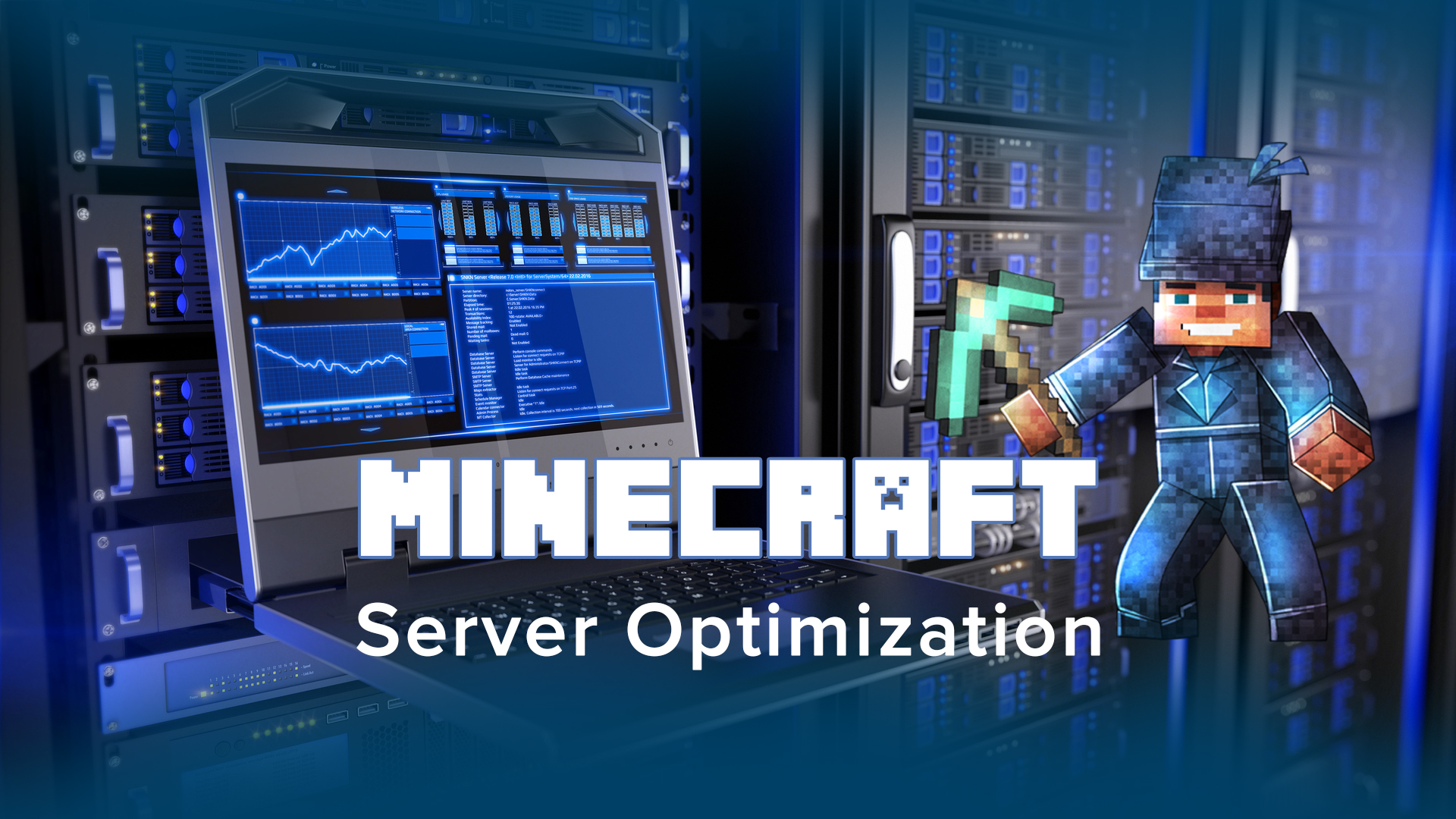
Minecraft Server Optimization: Fix and Stop Modded Server Lag

By Fernando Raymond | February 15, 2021
There are many ways to do Minecraft Server Optimization to stop modded server lag spikes.
Lag is perhaps the most annoying thing that a Modded Server player experiences.
While there are several types of lag that can occur on your Minecraft servers, such as Latency, TPS, and FPS lag; but in this post, you’ll learn the best ways to optimize your Minecraft Server.
How to Optimize Minecraft Server lag?
Now, you may be wondering exactly what causes lag on the Minecraft server. Well, there are several causes, with the major ones as high CPU and memory usage, also including network issues.
Also read: How to Buy a Minecraft Server: 7 Checklists to Consider when Buying A Server!
But first, let’s explain the different types of Minecraft server lags!

Different Types of Minecraft server lags
The different types of lag are as follows: Latency, TPS, and FPS lag. Here, we’ll break down all the different types of lag and proffer the best solution to optimize your Minecraft Server.
1. Latency
Latency depends on network conditions and the server status to which you want to connect. You can easily test how bad latency is by “pinging” the server.
It determines the time for the server to receive the message and respond. You can ping a server in two ways, first is through the Minecraft client by hovering your mouse above the server’s green connection bar at the right. The display of a number followed by “ms”, means that the number is your ping.
The second way is by typing “ping ServerIP” after opening the command prompt, for example, “ping play.seekahost.co”, which may take a second to complete the test but you’d get the average ping displayed.
The lag in connection correlates directly with ping, which refers to the network latency between the client-side and a Minecraft server. It also reflects in milliseconds data how long it takes to process and travel. With a low ping as the best as lower latency means smoother gameplay.
2. TPS (Ticks Per Second)
TPS (Ticks Per Second) is the quantification of the overall server’s performance. The server beats, like the human heart, at a fixed rate of 20 TPS, which means one tick in every 0.05 seconds.
And with each tick, the various aspects of the server advances; like moving of mobs, growth of grass, mobs check surroundings and update their behavior, among others.
The server revolves around the beat of TPS and when at peak performance of 20 TPS, you’ll get nominal gameplay without a server-side lag. But if the server’s TPS drops, even by a few ticks, you’ll start to notice lag. TPS is determined primarily by the speed and capabilities of hardware used to host the server.
And the server’s hardware play an important role in the TPS, but it is not the only determinant. Even with the best hardware used for a server, it will not solely guarantee the best performance. The whole occurrence on the server also plays an equal role in determining the TPS. The mismanagement of a server can be as disastrous as substandard hardware.
3. FPS (Client Lag)
Low FPS generally comes with slow gameplay, as when your frame rate is low, playing the game will feel like watching a slow-motion movie with only a few different frames appearing on screen per second.
It makes the game feel laggier, which is the worst thing a player would experience. With a low frame rate on the server, it does not really mean that the server is lagging but your computer is not able to keep up with the game. If you have a consistent low frame rate on PC, you will need to upgrade the PC’s graphics card, RAM, or CPU.
There is quite some difference between low FPS and server lag, and low FPS and server lag may appear at the same time, so you may think that it is due to the server lag, but low FPS is a separate issue.
The lag from server-side is basically saying that there is trouble keeping up with the in-game activities. While low FPS, means that your computer hardware isn’t able to run what’s demanded by the in-game activities, even when the server has no lag, your client can still have low FPS.
How to Stop Minecraft Server Lag
These optimizations that can be used to improve the performance of your server and the combination of these will work best, but you need to tweak certain settings.
1. Reduce View Distance
By reducing the server view-distance, players can experience a better performance even from slower connections:
Simply log into Command Center, then from the server list, look for the server you would want to modify and click the Manage button on the right. Now, from the selected server, click the Files tab above the console.
And locate and open server. properties to find the line with view-distance. Reduce it from 10 to 4 or 5 and save the file. Finally, restart your server.
2. The Client Side Frame Rate
The server may seem to lag, but it’s actually your client. So check the client frames per second (FPS), by pressing F3 within Minecraft. This will display your current FPS, of which anything above 20 – 30 FPS would mean adequate gameplay.
If it’s below 20 FPS or below, then try to adjust the video settings in-game using the following settings:
For Performance: Max FPS
For Advanced OpenGL: On
For Graphics: Fast
Render Distance: Short or Normal
Smooth Lighting: Off
Also, you can use mods like FpsPlus and OptiFine to increase the frame rate and improve the client-side rendering performance. But note that these mods may rewrite the default rendering engine and game logic that the Minecraft game and other mods depend on. Albeit, some people would trade stability for improvement in performance
3. Solving Latency Issues
CPU Usage is below 100% what it means is transient network connection issues. And if you’re far from your server that can make your Minecraft serverless responsive. So, it is recommended that you try to use a wired connection and ensure that users on your network are not downloading large files or anything that consume a lot of bandwidth.
You and other players should test the connection quality from your PC to server by testing in-game and running ping and traceroute commands.
In-game: connect to the server with Minecraft client and log into Command Center. From the server list, look for the server you would want to modify and click the Manage button. From the console, type “say test” and press enter. Now, check if the test appears in your game window. Any delay means there is network latency.
Conclusion
Overall, choosing a high-performance Minecraft server for your gaming needs may be all that you need to scale all these hurdles, especially if you’re just getting started!
SeekaHost offer support for all server types, and also have optimized software and top quality hardware to deliver high-performance Minecraft server hosting with countless mods. And you can easily switch from one server type to another, all at an affordable price. So now, nothing stops you from getting your Minecraft server up and running today!
Author Profile
- Founder & CEO - SeekaHost
Latest entries
 OtherNovember 10, 2021Minecraft Conversion Guide: What You Need to Know before Switching from Minecraft Java to Bedrock
OtherNovember 10, 2021Minecraft Conversion Guide: What You Need to Know before Switching from Minecraft Java to Bedrock Minecraft Playing TipsOctober 31, 202115 Best Minecraft Seeds: How to Pawn for the best Adventures
Minecraft Playing TipsOctober 31, 202115 Best Minecraft Seeds: How to Pawn for the best Adventures OtherAugust 18, 202115 Minecraft Vocabulary Words You need to Get Started on Your Minecraft Adventure
OtherAugust 18, 202115 Minecraft Vocabulary Words You need to Get Started on Your Minecraft Adventure Minecraft Playing TipsAugust 5, 202110 Best Minecraft Maps & Where to get the best Minecraft Adventure Maps
Minecraft Playing TipsAugust 5, 202110 Best Minecraft Maps & Where to get the best Minecraft Adventure Maps

